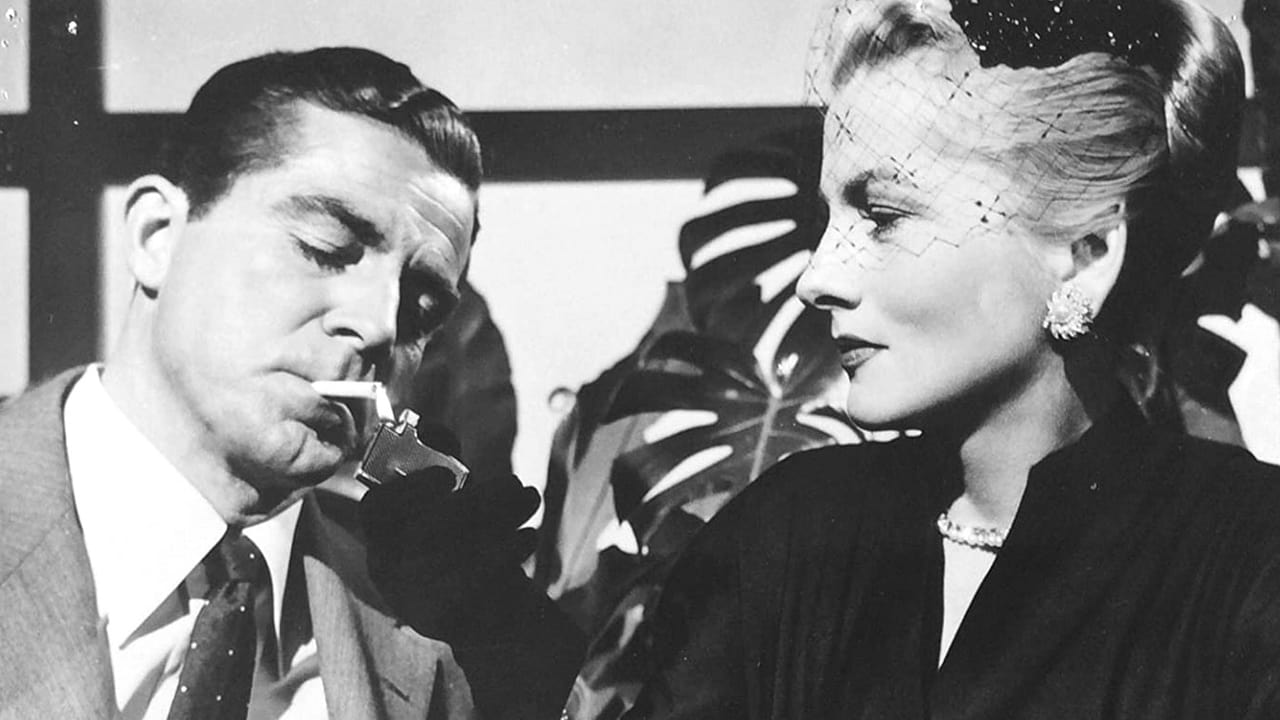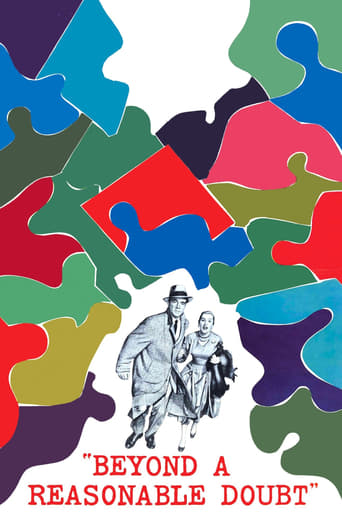

disgusting, overrated, pointless
... View MoreThis story has more twists and turns than a second-rate soap opera.
... View MoreA lot of perfectly good film show their cards early, establish a unique premise and let the audience explore a topic at a leisurely pace, without much in terms of surprise. this film is not one of those films.
... View MoreThe film may be flawed, but its message is not.
... View MoreWe have an interesting premise here served with a nice twist while keeping your attention. I gave it a seven because today it would be considered a worthy entry into the suspense genre. I am surprised it didn't do well when released. It is always pleasure to watch Dana Andrews work as he is able to communicate and reach his audience with little or no effort while causing us to believe the character he is portraying. The story is interesting and when this movie is over, it has potential for good discussion as well criticism. It is not a rich production but a rushed one sort of like someone wanted to get this out in record time and for next to nothing giving it a lack of depth. The story picks up midway and then has us running along side of it eager to see it unfold and justice done. For people who like courtroom drama, there is a satisfaction here as well as a history lesson too. There were no Miranda rights back then, you could be charged with little or no evidence and executions were carried out right away. Today it takes at least 13 years to execute someone for fear they might innocent thus giving them the benefit of the time doubt. I always enjoy watching these older movies to study the streets, cars, talk, signs and people at random. Have a snack and enjoy
... View MoreIn his last film in the USA before returning to Germany where he had left to escape the Nazis in the Thirties, Fritz Lang takes up the case of capital punishment and its application, especially when the case is a circumstantial one. Unlike the remake of Beyond A Reasonable Doubt with Jesse Metcalfe as the reporter and Michael Douglas as a corrupt District Attorney, both Sidney Blackmer as a newspaper publisher and Sheppard Strudwick as the politically ambitious DA hold each other in respect. Blackmer is not happy with Strudwick running up a string of murder convictions as a platform to be governor.He and prospective son-in-law Dana Andrews agree to frame Andrews with a string of manufactured evidence all carefully documented with photographs to have the police arrest him for murder of a burlesque queen that the police are stumped about. It certainly works all right, but as the case is coming to verdict, Blackmer is killed in an automobile accident and the evidence burn with him. Andrews is left in quite the jackpot.How it all works out is for you to see. Andrews is not abandoned by fiancé Joan Fontaine who is Blackmer's daughter. She does what she can and toward the end of the film her performance dominates.Fritz Lang certainly builds the tension worthy of Alfred Hitchcock himself. One scene did have me baffled. After the police have gotten those arranged clues, Andrews makes some moves on burlesque dancer Barbara Nichols who resists his advances. I could not quite believe that one at all.This original version is a notch or two above the Metcalfe/Douglas remake. Though it got an interesting alternative remake, this is still the one to see.
... View MoreBeyond a Reasonable Doubt (1956) ** 1/2 (out of 4) Frustrating film about a journalist (Dana Andrews) who decides to show that the current court system has a lot of holes in it by framing himself for the murder of a dancer. The plan is to be convicted by a jury and sent to death row where he, along with the help of his girlfriend's father (Sidney Blackmer), will admit that they were just trying to bring down the system. Lang's final American film has a terrific idea but none of it really comes together and when the end credits come up you can't help but be very, very disappointed. All of the elements for a great film are right here but I guess Lang was in a hurry to get back home because his direction is way too laid back and he really never brings any life or energy to the film. The biggest problem is the first hour where the investigation and trial take place because we know what's going to happen and we know to expect a twist in the story. When this twist does happen it comes as no surprise because it's the exact same twist anyone would be expecting to happen. When this twist finally appears it actually kick starts the movie a bit but by this time it's way too late. The final twenty-minutes of the film finally gets some drama going and we get yet another twist that I certainly didn't see coming. Lang appears to have snapped out of his sleep-walking and it's a shame more detail and thought wasn't given to the first portion. The performances are a mixed bag as the usually reliable Andrews pretty much goes through the motions here. Not once did I see any real emotion coming from him as he appears bored and just walking through the bit. Joan Fonataine turns in a fine performance as the girlfriend and Blackmer is good as her father. Philip Bourneuf is also good in the role of the prosecutor. There are many good things in this film but sadly there are some bad ones that keep this movie from being a masterpiece. It's hard to believe that the first part of this movie could be so flat but perhaps the filmmakers should have had the first hour trimmed down to twenty-minutes and then make the final moments stretched out and centered the majority of the movie on them. This is still a noir worth seeing but I really wish I could have called this a masterpiece.
... View MoreImagine an innocent man convicted for a crime he did not commit, being tried and found guilty. The laws of that particular state demand a sentence of death on the electric chair. After meeting the fate ordered by the verdict, the man goes to his death and when all is done, new evidence shows someone else was the real culprit. Is that justice?That is the point of Austin Spencer, a newspaper publisher, completely opposed to the death penalty. His own future son-in-law, Tom Garrett, a novelist, could not agree with him much more. Spencer wants to build a fake case with the help of Tom, in which a horrible crime in the news is brought to the attention of the police and the District Attorney. For that, Tom Garrett chooses the case of a burlesque dancer that was found dead and the case proves to be a mystery for the law enforcement people. Tom will act the part of the elusive man sought by the police as the killer.Austin and Tom fabricate a story that follows closely the real murder. Austin wants to document the way they prepared the fake case. Tom, reluctantly agrees to go along and pose as the assassin. His own wedding to Austin's daughter, the lovely Susan Spencer, might be in jeopardy. If Tom is condemned to die on the electric chair, Austin will have all the evidence to render the case for capital punishment for Tom a mockery of the system.Fritz Lang directed this RKO 1956 film. The director had a vivid imagination; evidently he was intrigued by the application of justice in his adoptive country, as shown in the magnificent "Fury" of his early Hollywood career. The screenplay by Douglas Morrow offers a satisfying courtroom drama with an ironic twist most viewers do not expect.Dana Andrews is at the center of the picture as Tom Garrett, a successful novelist in his own right, much in love with Susan Spencer. Mr. Andrews was an actor that delivered, as is the case here, although his style was a terse approach to his characters. Sidney Blackmer, a veteran actor himself, is also at his best with his take of the publisher with a conscience that wants to see the death penalty abolished in his lifetime. Joan Fontaine appears as Susan Spencer. Her role could be seen as supporting, because she is relegated to just adorn the film with only a few important scenes to her credit.The supporting roles are more interesting in the film. Barbara Nichols is perfect as the burlesque girl at the center of Austin Spencer's plans. Bob Hale, Shepperd Strudwick, Phillip Bourneuf, Ed Binns, and Joyce Taylor, among the large cast do a wonderful job in the film.Highly recommended for all Fritz Lang's fans.
... View More